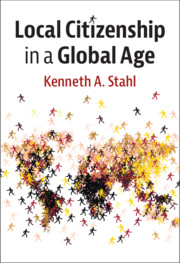Book contents
- Local Citizenship in a Global Age
- Local Citizenship in a Global Age
- Copyright page
- Dedication
- Contents
- Figures and Tables
- Acknowledgments
- Introduction
- Part I Citizenship Federalism
- 1 Three Models of Citizenship
- 2 Local and Federal Citizenship
- 3 A Short History of Local Citizenship
- Part II “Noncitizen Citizens”
- Part III Race, Space, Place, and Urban Citizenship
- Conclusion
- Bibliography
- Index
1 - Three Models of Citizenship
from Part I - Citizenship Federalism
Published online by Cambridge University Press: 08 June 2020
- Local Citizenship in a Global Age
- Local Citizenship in a Global Age
- Copyright page
- Dedication
- Contents
- Figures and Tables
- Acknowledgments
- Introduction
- Part I Citizenship Federalism
- 1 Three Models of Citizenship
- 2 Local and Federal Citizenship
- 3 A Short History of Local Citizenship
- Part II “Noncitizen Citizens”
- Part III Race, Space, Place, and Urban Citizenship
- Conclusion
- Bibliography
- Index
Summary
Chapter 1 explains how the modern state simultaneously maintains commitments to three different conceptions of citizenship that are all in some tension with each other: the republican, liberal, and ethno-nationalist models of citizenship. Liberalism stresses individual market freedom and natural rights; republicanism emphasizes collective civic activity; ethno-nationalism is based on solidarity and identity. We have managed to mute the inherent conflicts among these conceptions through the distinction, long central to the idea of citizenship, between the “public” and “private” spheres. Citizens live primarily private lives, where they are ruled by the marketplace and individual desires, but occasionally enter the public sphere to engage in politics, where they become part of an organic polity unified by a common sense of purpose and shared civic identity.
- Type
- Chapter
- Information
- Local Citizenship in a Global Age , pp. 21 - 39Publisher: Cambridge University PressPrint publication year: 2020

